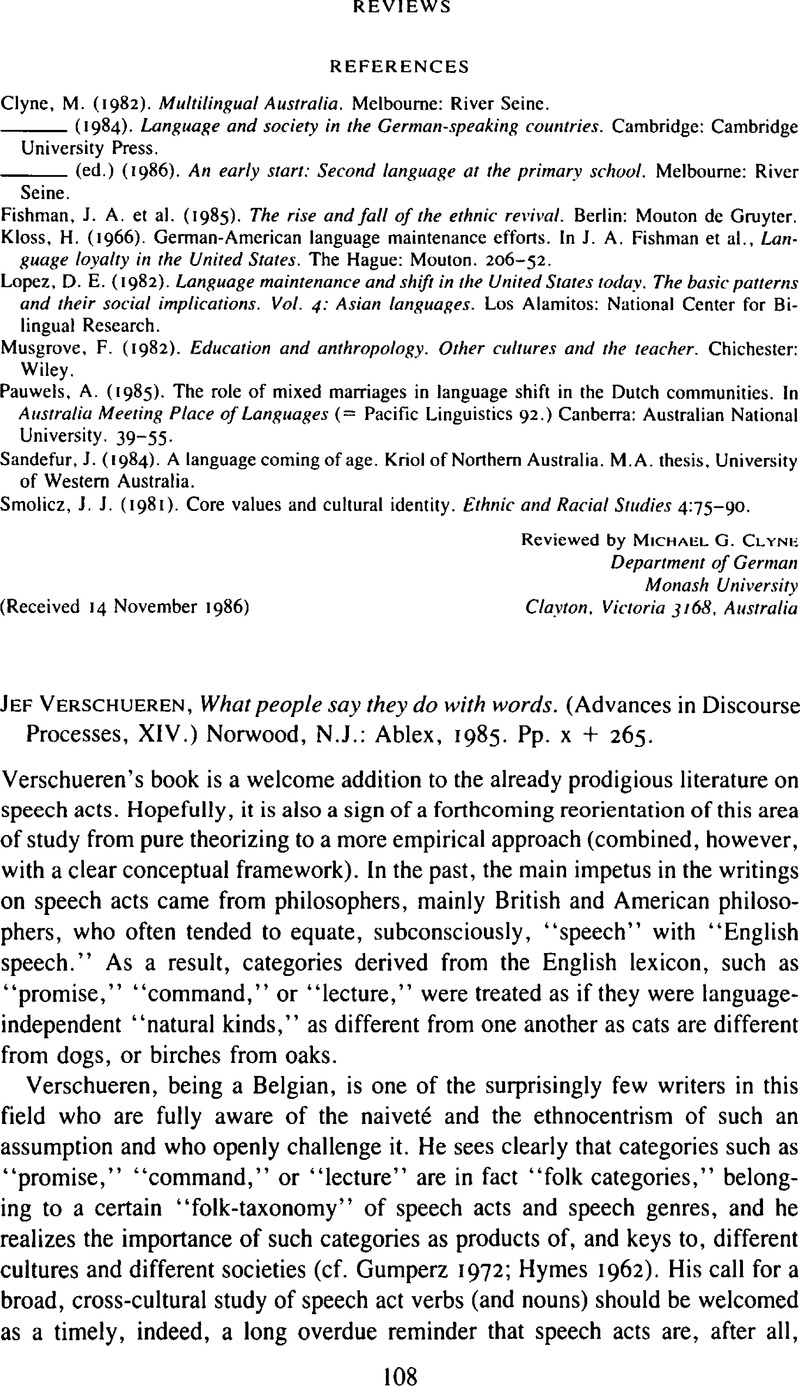No CrossRef data available.
Article contents
Jef Verschueren, What people say they do with words. (Advances in Discourse Processes, XIV.) Norwood, N.J.: Ablex, 1985. Pp. x + 265.
Review products
Jef Verschueren, What people say they do with words. (Advances in Discourse Processes, XIV.) Norwood, N.J.: Ablex, 1985. Pp. x + 265.
Published online by Cambridge University Press: 18 December 2008
Abstract
An abstract is not available for this content so a preview has been provided. Please use the Get access link above for information on how to access this content.

Information
- Type
- Book Review
- Information
- Copyright
- Copyright © Cambridge University Press 1988
References
REFERENCES
Berlin, B., & Kay, P. (1969). Basic color terms: Their universality and evolution. Berkeley and Los Angeles: University of California Press.Google Scholar
Dixon, R. M. W. (1971). A method of semantic description. In Steinberg, D. D. & Jakobovits, L. A. (eds.), Semantics: An interdisciplinary reader in philosophy, linguistics, and psychology. Cambridge: Cambridge University Press.Google Scholar
Finnegan, R. (1969). How to do things with words: Performative utterances among the Limba in Sierra Leone. Man 4:537–52.CrossRefGoogle Scholar
Gumperz, J. (1972). Introduction. In Gumperz, J. & Hymes, D. (eds.), Directions in sociolinguistics. New York: Holt, Rinehart & Winston. 1–25.Google Scholar
Hymes, D. (1962). The ethnography of speaking. In Gladwin, T. & Sturtevant, W. (eds.), Anthropology and human behavior. Washington, D.C.: Anthropological Society of Washington. 15–53.Google Scholar
Kochman, T., (ed.) (1972). Rappin' and stylin' out. Urbana: University of Illinois Press.Google Scholar
Rosaldo, M. (1982). The things we do with words: Ilongot speech acts and speech act theory in philosophy. Language in Society 11:203–37.CrossRefGoogle Scholar
Rosch, E. (1977). Human categorization. In Warren, N. (ed.), Studies in cross-cultural psychology. New York: Academic.Google Scholar
Rosch, E. (1978). Principles of categorization. In Rosch, E. & Lloyd, B. B. (eds.), Cognition and categorization. Hillsdale, N.J.: Erlbaum.Google Scholar
Wierzbicka, A. (1984). Apples are not a kind of fruit: The semantics of human categorization. American Ethnologist 11(2):313–28.CrossRefGoogle Scholar
Wierzbicka, A. (1985b). A semantic metalanguage for a cross-linguistic comparison of speech acts and speech genres. Language in Society 14:491–514.CrossRefGoogle Scholar
Wierzbicka, A. (in press). Two Russian speech act verbs: Lexicography as a key to conceptual and cultural analysis. In Stolz, B. (ed.), Selected papers from the III World Congress of Soviet and East European Studies. Linguistics volume.Google Scholar

